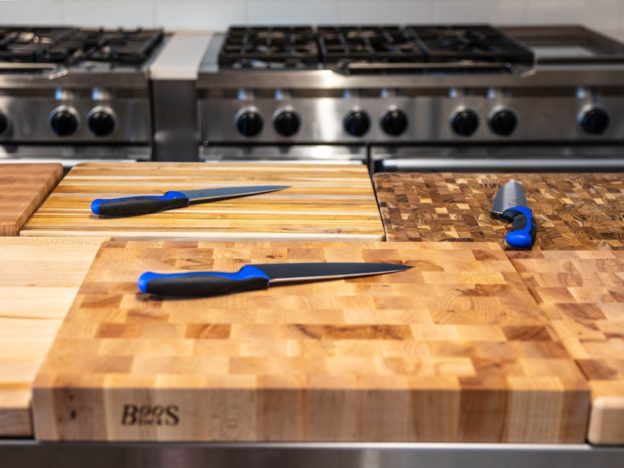After each use, wash your timber chopping area with a mild dish soap and hot water. Wash effectively and dry with a cloth. Then allow it air-dry entirely (bacteria die once they aren’t held moist). To sanitize the surface, you might want to wipe your cutting table with white vinegar after use. Vinegar is effective against salmonella, E. coli and staphylococcus. You can use it with a report towel or, for simplicity, have a spray package filled up with vinegar practical in your kitchen. ALWAYS CLEAN THE CUTTING BOARD SURFACE THOROUGHLY IF YOU’VE CUT UP FISH OR POULTRY.
When cutting garlic or onion and cutting fish, getting some food smells on your board is unavoidable. To eliminate these scents, you can wipe your board with rough sodium, orange, or cooking soda. Allow it to stay on the board for a couple of moments, then wash down the surface. Wash well and give it time to dry.
DO NOT soak your panels (or some other wooden utensils) in water or they’ll crack and warp! DO NOT put them in a dishwasher to completely clean them. Because of the way many chopping panels & butcher blocks are made (gluing items of wood together) doing this may cause your board to fall to pieces!
To prevent discoloration and to help keep food smells and bacteria from building at first glance, hold your panel well-oiled. Use a gas which can be used again and again, such as for example spring oil. Nutrient oil is obvious, tasteless, odorless, secure around food and can fill the wood pores. Stay away from olive, good fresh fruit and plant oils, or pet fats, as these oils can get rancid over time. Make sure your board is clean and dried, then wipe the gas in your cutting panel in an even layer using a clear, smooth material or report towel. Wait for it to soak in to the timber (for at least a couple of hours or over night works also!).
Add more fat if required if you can find dried spots. Wipe/buff down any surplus oil with a clean, dried cloth. When you initially get your custom wood cutting board or butcher stop, you might want to achieve this once per week for three days and then monthly for 3 months. There after, once a month, or more often if you are using your cutting board extensively, should do the trick. End-grain boards need more oil compared to the flat-grain or edge-grain boards because the gas moves greater in to the end-grain fibers. REMEMBER YOUR BOARD LOVES TO BE OILED!
Following your board has been veteran, you may also work with a beeswax/oil combination (1/2 tsp. of beeswax microwaved with 1 pot of mineral fat for 45 moments placed on the board while it’s warm) every a few months for a water-resistant surface. That shields the timber from wear and tear and allows it a longer life. (You can also wipe a tiny stop of difficult beeswax at an perspective across your table area and edges & rub it in to the panel together with your fingers. This essentially water-proofs the surface).
To renew your chopping panel, in between spices, piece a fresh lemon in two and wipe it onto the materials of your chopping board. Also with this particular attention, DO NOT allow liquids to stay on your cutting table for lengthy times of time. Wipe water, liquid, brine and the drinks from new meat off your panel the moment probable to avoid it from soaking to the timber, that may trigger the cutting panel to increase, the timber to soften, and the strength of the fixed joints to deteriorate. Actually employing a good material scraper or spatula may help keep the chopping area clean and sanitary. Scraping the surface can remove 75% of the moisture.
If your panel is reversible, turn it around and use the other part regularly. And use different aspects of your board for cutting – don’t do your entire chopping in the biggest market of the table or that region can wear faster! Store your chopping panel in a dried place away from food and any contaminants. Stand your boards on side after cleaning and drying to avoid warping.

